Class Examples
Mediathread can be used in the classroom to support collection and investigation of media artifacts. As a result, Mediathread has proven most useful for artifact analysis and recorded performance review. The following examples illustrate some ways instructors have incorporated artifact analysis and recorded performance review into their class timeline.
Embodied Expressions through Multimedia
Course: Cognitive Linguistics
Instructor: Dr. Reyes Llopis-Garcia
Mediathread features used: collecting, selection assignment, composition assignment
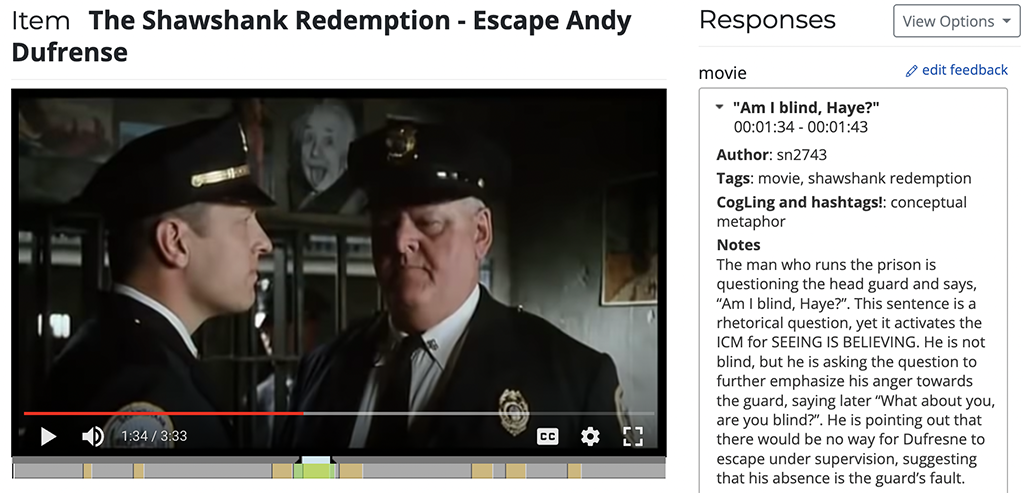
A screenshot of a selection made on a collected piece of video media.
Assignment Purpose & Description
Students construct a multimedia essay that demonstrates their understanding of “Mind and Body in Space”. Students use metaphors in the form of popular multimedia to illustrate their argument.
This multimedia essay comes at the end of the class. Professor Llopis-Garcia also has students do simpler assignments in Mediathread that lead up to this assignment. These include selecting pieces of media and analyzing linguistic embodied expressions in different languages, as well as adding clips to the course collection. These clips are tagged using a course vocabulary (terms used in cognitive linguistics that are discussed in class) that Professor Llopis-Garcia co-creates with the students.
Assignment Requirements
Write an essay of 3-5 pages.
View the course collection to decide on a topic.
Use items from the course collection to support your analysis, including items collected by other students.
Advantages of Mediathread
Students are able to use Mediathread to closely link scenes from popular media to cognitive linguistics concepts. Llopis-Garcia also encourages a sense of community, as students not only see each other’s work, but also use each other’s work in their own assignments. This use of each other’s work is seen both through the collection of popular media clips and the course vocabulary.
Group Analysis of Language Teaching
Course: Classroom Discourse
Instructor: Professor Hansun Waring
Mediathread features used: discussion assignment
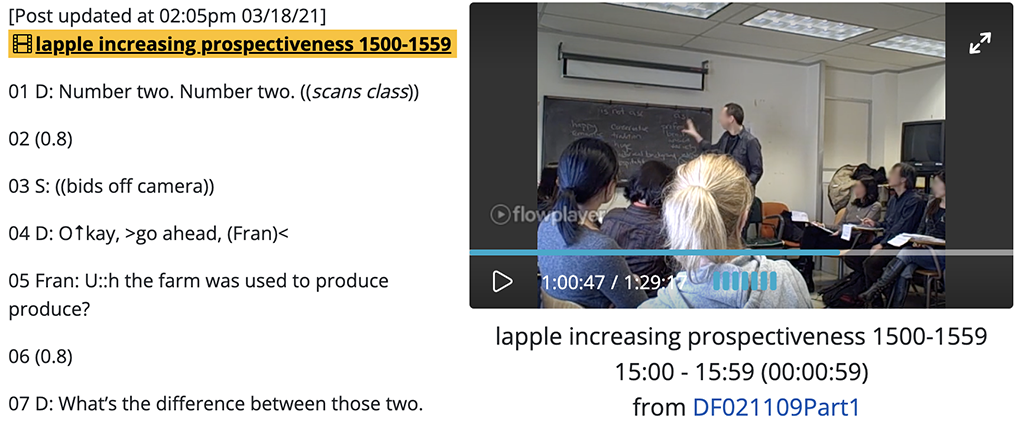
A discussion thread example where the faculty responds to a student (off-screen), and another student response follows.
Assignment Purpose & Description
In this discussion assignment students analyzed a recorded lesson on language learning in a college classroom. The purpose of this assignment is for students to be able to identify in the video conceptual elements that had been taught in class and share through discussion with other students what they had found.
Assignment Requirements
Students were asked to find a clip from a recorded lesson on language learning and start a discussion by pointing out how it connects back to one of the course concepts that had been taught in class. Students were then asked to make at least one reply to other students’ posts.
Advantages of Mediathread
The discussion feature on Mediathread allows students to be able to respond to each others’ annotated selections. This gives students the opportunity to share ideas and opinions with each other, as well as get feedback.
Guided Reading Video Analysis
Course: Inclusive Approaches to Inclusive Teaching K-12 Literacy: Theory and Practice
Instructor: Dr. Lisa Edstrom
Mediathread features used: selection assignment, composition assignment
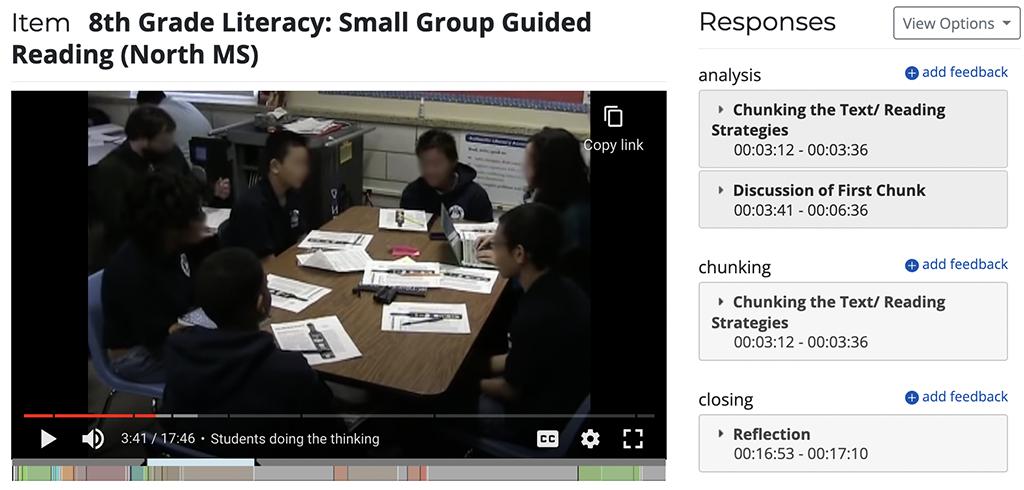
A portion of the student-submitted selections in a selection assignment. Selections are displayed in expandable card form with title and timestamp in the preview.
Assignment Purpose & Description
In her course, professor Edstrom teaches her students, who are pre-service elementary and secondary school teachers about the theory and practice of guided reading in the classroom. She uses Mediathread for a multi-part assignment that has students start off with analyzing and annotating recordings of teachers facilitating small group guided reading discussions in various contexts. Students later use these analyses to write a short composition explaining in their own words, that answers what guided discussion is and discusses how they would use it in their own classrooms.
Assignment Requirements
The first part of the multi-part assignment has two selection assignments that are posted; Guided Reading at the Elementary Level, and Guided Reading at the Secondary Level. Students choose the level they will likely be teaching in and complete the associated assignment. The task for each assignment is the same; to watch a recording of a teacher facilitating a small group guided reading discussion and make a total of 5 annotated selections noting their observations, including the following:
- A selection that illustrates the essential reading strategy that is being taught.
- A selection that shows how the teacher supports a reader who may be struggling.
- A selection that shows the teacher giving directions.
The other 2 selections can be general observations or something learned from the video. In the second part of the assignment students will have to use the selections that they and their peers made as part of a short composition (no more than 5 paragraphs) that explains what guided readings are and how they may consider using it in their own teaching.
Advantages of Mediathread
This assignment utilizes both the selection assignment for video and the composition assignment as parts of a larger assignment. By creating the selections on the video as well as having selections made by their peers available, students can then easily insert those selections into a composition as reference to statements made in the composition. This assignment is a great example of how to use the different tools in Mediathread in unison.
Historical Map Analysis
Course: Colonial Cities of America
Instructor: Professor Gergely Baics
Mediathread features used: selecting
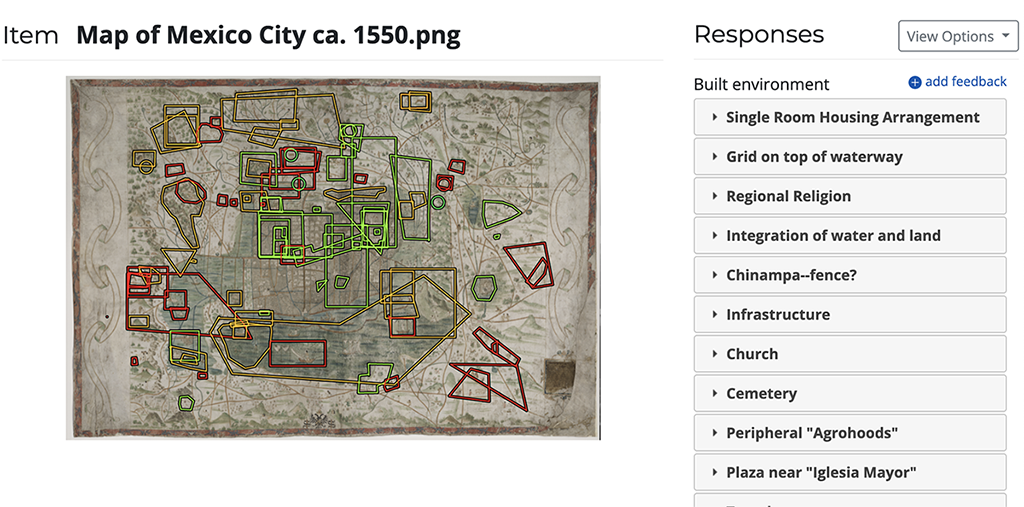
A screenshot of a selection assignment of a map. All student selections are viewed on the map and a portion of the selections are on the right in a list.
Assignment Purpose & Description
Professor Baics asked students to analyze the different characteristics of a high definition map of Tenochtitlan / Mexico City that was created around 1550. This task is meant to be a precursor to a wider conversation about colonial era Mexico City.
Assignment Requirements
Students studied the map and had to make selections for what they found interesting from each of the following characteristics that can be found on the map: ecological environment, built environment, and daily life. When making the selection they had to list the specific characteristic, add tags (e.g. church for built environment), and write a brief paragraph explaining the rationale for the choice.
Advantages of Mediathread
Mediathread’s selection tool allows students to mark annotations on the map with tagging and explanations. Professor Baics also wanted students to see responses from their classmates only after they first submitted their own. Mediathread allows this option in its assignment settings.
Popular Music Analysis
Course: Masterpieces of Western Music
Instructor: Dr. Ralph Whyte
Mediathread features used: collecting, selecting, composition assignment
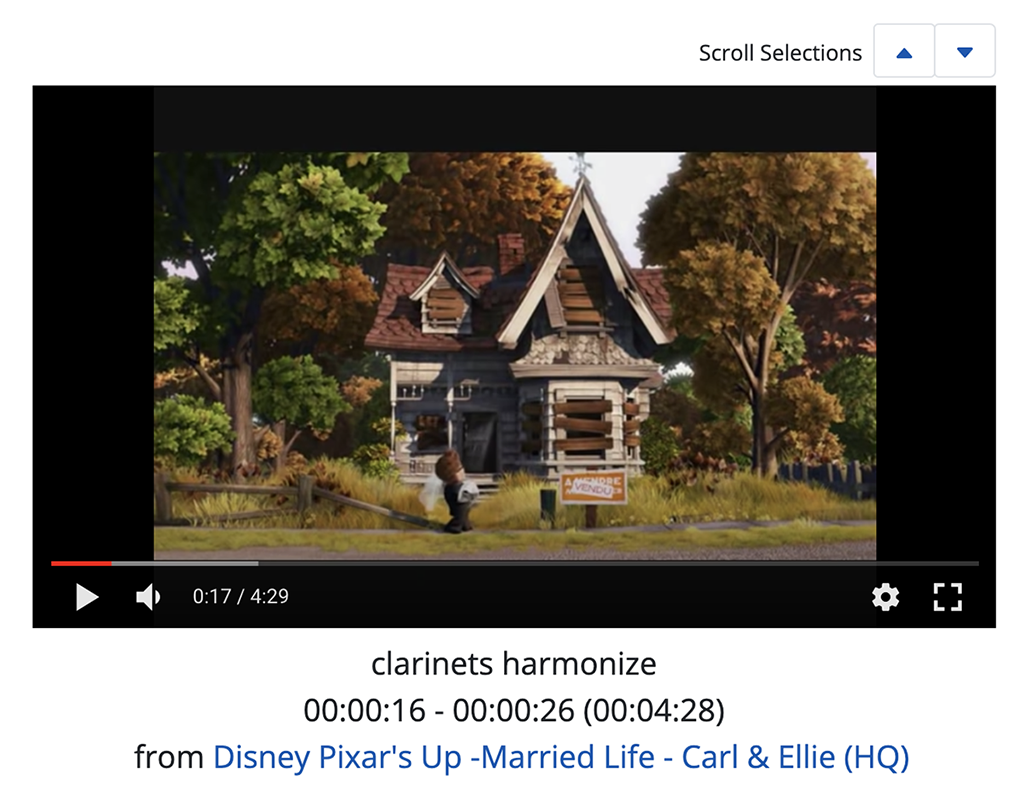
A screenshot of a selection made on a collected piece of video media.
Assignment Purpose & Description
Professor Whyte created an assignment where students write an argument about music incorporating the “representational, expressive, and formal techniques of music” using musical terminology.
Assignment Requirements
Students chose a piece of popular music and then selected portions of the music to highlight. Each selected portion is given a name that fits into their written argument. For example, a student might write about how the music accelerates in tempo at the chorus. They select the portion of the music that illustrates this concept and link it in their text.
The assignment must have at least five selections of their song choice.
Advantages of Mediathread
Students use Mediathread to weave in particular portions of the music into the text. The text and the music become more closely intertwined, and thus the students’ understanding of the terminology and the music is reinforced.
From a user experience perspective, both student and faculty can easily connect the text to the music. The student can visually and aurally see the impact of any edits they made, and the faculty can more easily review, provide feedback on, and experience the connection that the student intended.
Lastly, the assignment (as designed by Ralph Whyte) grants the student the opportunity to connect course material to the popular music that is in their daily ethos.
Self-Reflection and Analysis
Course: General Chemistry
Instructor: Sarah Hansen
Mediathread features used: uploading, selecting, composition
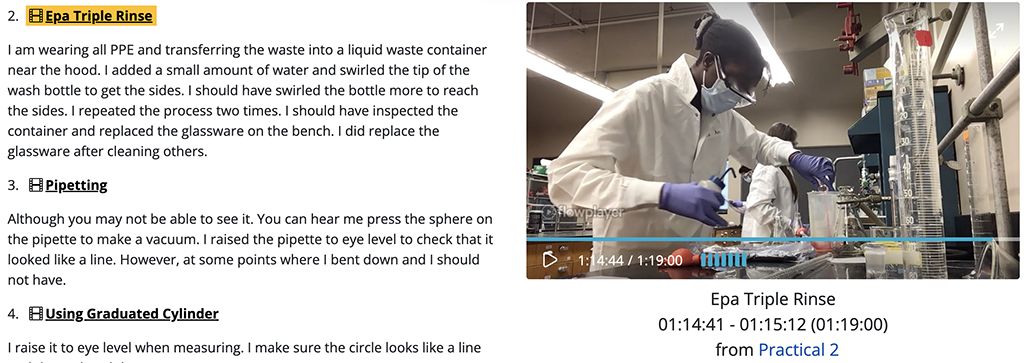
This assignments tab shows a series of example Mediathread assignment titles.
Assignment Purpose & Description
Professor Hansen created this assignment as a way for students to self-reflect and critically analyze the use of procedures in a chemistry experiment. In response, she provided students with essential feedback to make adjustments on future experiments.
Assignment Requirements
Students were asked that all the procedures of the experiment be recorded and uploaded to their Mediathread collection space. Professor Hansen then asked students to snip out selections from the video that represented the essential procedures of the experiments. Finally, each selection had to be critically analyzed and evaluated by the student and written into a composition assignment submission.
Advantages of Mediathread
Some types of lab experiments, such as in chemistry, are done in real time, and instructors can’t pay attention to all students at all times to make evaluations of their procedures, or to pinpoint an error when something went wrong in the result of the experiment. Likewise, for the student it is sometimes hard to notice when something was done incorrectly when done in the moment, without time to reflect.
By having students record and make selections for each procedure, each component for each student can be analyzed by both the student and instructor so that proper feedback is given and so that the students can make adequate adjustments.